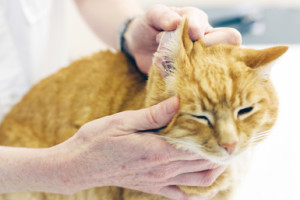Uncategorized
How Do I Know If My Pet Has Rodenticide Toxicity?
 With the cold weather upon us, many other four-legged friends such as mice are taking up refuge in our houses trying to keep warm. In order to control this problem, many happen to go to our local hardware store and put out rodenticides. Unfortunately, several of our curious pets may venture upon the “mouse bait” and ingest it. This can cause serious problems which can include death if not noticed and proper treatment received.
With the cold weather upon us, many other four-legged friends such as mice are taking up refuge in our houses trying to keep warm. In order to control this problem, many happen to go to our local hardware store and put out rodenticides. Unfortunately, several of our curious pets may venture upon the “mouse bait” and ingest it. This can cause serious problems which can include death if not noticed and proper treatment received.
There are several different rodenticides such as anticoagulants, bromethalin, and cholecalciferol that are used and they all attack different body systems. So it is important to know the active ingredient so that proper treatment can be implemented.
Signs of rodenticide toxicity do not show up for several days and sometimes are very subtle and unrecognized. The most common sign may be bloody saliva in your pets water bowl. If you suspect that your pet has ingested the poison, it is best to seek medical attention as soon as possible. Take the poison box with you. That way the veterinarian can see which product has been ingested and proper medications will be given. Your veterinarian will want to induce vomiting as soon as possible, including giving activated charcoal to reduce the absorption of it in the stomach. Other products such as Vitamin K, or lasix may be giving depending on the poison. Bloodwork and a urinalysis will be done to assist the veterinarian with the diagnosis and prognosis.
A quick and easy recipe to use for getting your dog to vomit would be to give your dog one to two slices of white bread and then give a mixture that consists of 3 tablespoons of Hydrogen Peroxide, and 1 tablespoon of peanut butter. Wait 10 minutes to see if your pet vomits. If it doesn’t repeat it again.
As the old adage says, an ounce of prevention is worth a pound of cure. It really holds true here. To create a safer environment for your pet, prevent access to areas where you lay poisons for mice. Keep garage doors shut, cabinets closed, and lock the basement. Never put poison outside near your dog’s run, and should you find dead rodents, remove them immediately. Ingesting a poisoned mouse can be just as toxic as eating the poison from the trap.
If you have any other questions, don’t hesitate to contact our office.
Tips For Taking Care of Your Aging Pet
 Regular professional veterinary care is essential to the health of your older pet. Not since your pet was a puppy or kitten have regular check ups and vaccinations been so important. Preventive veterinary care can add years and quality to the life of your older pet. Consider yourself, your pet, and your veterinarian and staff a team whose main goal is to keep your pet happy, healthy and in a loving relationship with your for as long as possible.
Regular professional veterinary care is essential to the health of your older pet. Not since your pet was a puppy or kitten have regular check ups and vaccinations been so important. Preventive veterinary care can add years and quality to the life of your older pet. Consider yourself, your pet, and your veterinarian and staff a team whose main goal is to keep your pet happy, healthy and in a loving relationship with your for as long as possible.
Dogs and cats are living longer than ever and that phenomenon is directly related to the fact that today people take such good care of their animals. Important changes affecting 85% of pets today, with a focus on nutrition, rapidly advancing veterinary care and loving environments are responsible for the life expectancy of animals to be extended, in general, a five years longer across the board than was previously the norm. The human-animal bond is strong. Many people today take fantastic care of their pets and have educated themselves on the best protocols for these important friends. Every aspect of how to care for the family pet is considered in terms of diet, vacations, exercise, entertainment, grooming, wellness comfort, aging and more.
Three important aspects of the aging pet we consider are:
Diet: Obviously starting early is important. Two things can happen to the aging patient: becoming either over or under weight. It is easier to prevent a pet from being overweight than it is to diet him but we are successful at helping the committed owner who wants to help their pet lose weight. This involves selecting the correct snacks, as well as the appropriate food. The underweight and aging pet can be a bit more of a challenge and the underlying causes must be diagnosed but in most cases we can help clients maintain a healthy weight in the elderly pet. One of the most important aspects of diet in the geriatric pet is being aware of the changes going on with respect to his or her vital organs and metabolism and selecting the best diet, supplements, and snacks for his or her particular condition.
There are several prescription foods available that directly target the aging brain. We would be happy to discuss and make recommendations of the excellent choices that are out there.
Preventative Care: As you are aware, pets are very stoic in the face of considerable disease and one of the difficult aspects of care in veterinary medicine is the fact that we ofter do not see the pet until a disease process is very advanced. A well-thought out and followed preventative plan is a great way to minimize testing and monitoring and can offer tremendous insight to what is going on inside the pet. There are medications available that target the diseases and changes that adversely affect the older patient and we can guide you toward those after an evaluation that will tell us if your pet is in need of preventative care.
It is very comforting to pet owners when an elderly patient has a normal physical exam and consult, blood pressure, ECG, and urinalysis. We ask specific questions to discern if there are subtle changes in the animal that might lead us to want further diagnostics.
Exercise: Exercise should be maintained for the elderly patients. Did you know that 15 minutes 3 times per week of forced exercise will go a long way in maintaining a healthy metabolism in your friend? As with diet, exercise should be implemented at a young age and adjusted as the pet ages.
Cognitive function can be supported in the geriatric pet with specific supplements and there are medicines available if your friend is found to be in need. Antioxidants, healthy fats, and pain medications can keep the old aches and pains away just like us! Certain activities and ideas to encourage the older pet and suggestions to protect them, especially when he or she is alone, are available if your need them.
Older pets need regular veterinary care to prevent disease and/or diagnose it early in its course. Many veterinarians have special programs to monitor dogs in their later years of life. Good communications between the owner, dog and veterinarian can keep the pets healthy and make their senior years to be wonderful years. At the end of your pet’s life, your veterinarian can help you in making decisions, provide support, understand and share your grief and celebrate, with you, the life of your pet.
As always, the health of your pet is of utmost importance at our office. Please CONTACT US if you have any questions.
October is National Pet Adoption Month
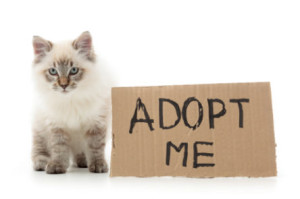 October is National Pet Adoption Month and many people constantly are adopting pets from rescue organizations. Peoples lives are enriched in ways that they have never dreamed possible. Bringing home a new pet is such an exciting and fulfilling experience, but it can be a bit daunting as well, especially if you have never shared your home with a furry companion. Here are some tips to get your relationship off on the right foot.
October is National Pet Adoption Month and many people constantly are adopting pets from rescue organizations. Peoples lives are enriched in ways that they have never dreamed possible. Bringing home a new pet is such an exciting and fulfilling experience, but it can be a bit daunting as well, especially if you have never shared your home with a furry companion. Here are some tips to get your relationship off on the right foot.
Be prepared Before you bring your pet home, determine where your pet will be spending most of its time. Because it will be under a lot of stress with the change of environment, it may forget any housebreaking it has learned. An area with tiled, pergo, or linoleum floors may be best because it is easiest to clean up. You will also need to dog-proof the area where your pet will spend most of its time. This may mean taping loose electrical cords to baseboards, storing chemicals on high shelves, removing plants, rugs and breakables. The more prepared that you are, the smoother your new family member’s transition will be.
Shop for the basics You will need a leash, collar, food and water dishes and of course food. It is best to know what your new adoptee is eating as an abrupt diet change can cause diarrhea and other problems. If you change its diet, do it as a gradual change like maybe over 10 to 14 days. One other thing to buy is a medal id tag. It does not replace microchipping, but it does help some. If you are planning on crate training your pet, it is best to wait and take your pet with you to purchase it. This way you will get the proper size.
Consistency Make sure all family members are on the same page. Ground rules need to be set and the family members need to agree to follow and enforce them. For instance, if you don’t want your new pup on the couch, all the training in the world won’t help if your child lets it sit there with you when you are not home. Also, caring for your pet is a family effort and endeavor, so it is important that everyone understands their particular roles and responsibilities.
Adjustment Over the first few days to few weeks, your new pet will be undergoing an adjustment period. These surrounding are new to him, so you may notice some anxiety issues that may include appetite loss or suppressed bowel habits. It may even hide under or behind furniture or stay in one room. Don’t be alarmed-this is absolutely normal behavior. Give the pet time to acclimate to your home and family. By showing patience, you will help it through a tough, scary time and it will show the pet how wonderful his new home really is.
Set Schedule It is best to set a schedule for feeding, toileting and play/exercise. From Day One, your dog will need family time and brief periods of solitary confinement. Don’t give in and comfort it when it whines when left alone. Instead, give it attention for good behavior, such as chewing on a toy or resting quietly. By sticking with a schedule that you created, your pet will be bonded with you in no time and the pet will be showing its true personality.
Veterinary Care Schedule a first visit to your pet’s veterinarian during the first week. Bring any and all medical and vaccination records that were supplied by the shelter or rescue from which you adopted your dog. This first visit os a great time to get clues about your pet’s personality and past history, so don’t be afraid to ask lots of questions. Also, if your pet is not microchipped, this is a good time to do it because true love is hard to replace.
Congratulations! If you follow these tips, you’ll be on your way to having a well-adjusted family member. Make sure to contact us if you have any questions!
What Do You Do If Your Pet Has An Ear Infection?
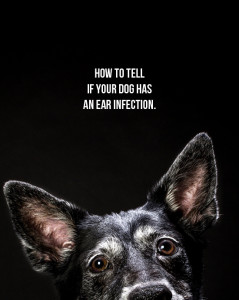 With the summer sun beating down on us and we try to break the doldrums of summer, many people are trying to keep their pets cool by allowing them to swim. Did you know that more than 20% of dogs have some form of ear infections? In the hot, humid areas, it can range up in the 50% range. Imagine that, 1 out of every 2 dogs having to deal with an ear infection. Otitis is considered a type of skin disease that is very common in pets and causes a lot of distress to owners and discomfort and pain to the pet.
With the summer sun beating down on us and we try to break the doldrums of summer, many people are trying to keep their pets cool by allowing them to swim. Did you know that more than 20% of dogs have some form of ear infections? In the hot, humid areas, it can range up in the 50% range. Imagine that, 1 out of every 2 dogs having to deal with an ear infection. Otitis is considered a type of skin disease that is very common in pets and causes a lot of distress to owners and discomfort and pain to the pet.
Full blown ear infections are easy to detect. There may be clinical signs that include odor, scratching or rubbing of the ears and head, discharge in the ears, redness or swelling of the ear flap or canal, shaking of the head or tilting to one side, pain around ears, or changes in your pets’ behavior.
Ear infections usually arise from primary and secondary factors that create a perfect storm for these infections. The primary factors are those that touch of the inflammatory process that create moisture, heat and stagnate air flow which allows the secondary factors such as yeast, bacteria, swelling and debris to take hold. The secondary factors are the ones that cause still more moisture, heat and stagnant air to build up causing a viscous cycle of misery for you pet.
The primary factors that cause ear infections include:
- Anatomy – The ear canal of a dog is L-shaped and many dogs have large pendulous ears. This traps warm air, debris and moisture, creating a perfect environment for the germs to grow. Also the Cocker Spaniel breed has more apocrine glands in the ear canal which produces more ear wax which compounds the problem.
- Environment – Frequent swimming, exposure to plants and pollens, time spent in wooded areas where plant awns or burrs can get lodged in the ear, or simply the humid heat of summer can set the stage for ear trouble.
- Allergies – Itchy, infected ears can be a classic sign of allergic skin disease in dogs. In fact otitis may be the first and only sign. What starts out as a simple ear infection often becomes a chronic problem until the underlying allergy is addressed.
- Parasites – Ear mites are more common in cats than dogs. Ear mites cause inflammation, discharge and an intense itch that can lead to self trauma and secondary infection. These can be easily treated with diagnosis and proper veterinary care.
- Foreign bodies – With pets that tend to like to run through tall grasses, plant awns can get lodged in the ear and cause intense itching, scratching, and secondary infection. These can be easily seen with the use of an otoscope on examination.
- Tumors – Infected tumors inside the ear trap moisture and debris and are the perfect place for germs to grow. These tend to be seen more in cats.
- Other medical conditions – Hypothyroidism and generalized skin disorders including seborrhea, can spark inflammation that leads to otitis externa.
The ear infections are not easy to miss, but the treatment only works when we address both the primary and the secondary causes. So a thorough examination is important to determine this. After looking at this, the veterinarian will then hone in on the ears. This will include looking at the ear canal and the ear drum with an instrument called an otoscope. Samples of the discharge may be taken to identify the yeast or bacteria by a microscopic examination or culture.
The first step in treating otitis externa is a thorough cleaning of the infected ears. A deep cleaning rids the ear of the secondary factors such as bacteria, yeast and debris. Sometimes the ears may be so painful, anti-inflammatories may be given to reduce the redness and pain first. In severe cases, your veterinarian may recommend that an ear flush be conducted under sedation so that special probes and deep flushing equipment can be used.
Once the ear is clean and dry, topical medications are prescribed to keep the yeast and bacteria under control. Your vet will prescribe medications that contain a combination of antibacterial, anti-fungal, and anti-itch medications. In severe cases, oral antibiotics or other medications may be used.
For treatment to be successful, the underlying cause must be addressed. This may include treating for ear mites, reducing swimming among other things. Your veterinarian may do further blood work or other diagnostics to probe for underlying health issues like allergies and hypothyroidism.
It is important to give immediate attention to the ear infections because numerous complications can arise which may be irreversible. These include chronic changes to the ear canals, ear hematomas, or middle and inner ear infections. Because of this please consult your veterinarian anytime you observe your pet performing frequent head-shaking, pain, redness or discharge from your pets’ ear. And of course, contact our office if you have any questions.
Get Your Pets Immunized!
 August is National Immunization Awareness Month. This observance offers the opportunity to remind the community of the importance of immunization to prevent disease. Each year thousands of pets succumb to diseases that could be preventable by vaccinations.
August is National Immunization Awareness Month. This observance offers the opportunity to remind the community of the importance of immunization to prevent disease. Each year thousands of pets succumb to diseases that could be preventable by vaccinations.
Giving your pet regular vaccinations is the secret to a healthy pet’s life. Vaccines now cover multiple diseases like DHLPP in dogs and FVCRP in cats. These diseases can cause illness in your pet so it is important to vaccinate to reduce the risk and protect the health of your pet. Other diseases that can be vaccinated against include Bordetella which is a upper respiratory disease in dogs and Lyme disease which affects the joints of your dog.
Not only is it important to vaccinate your pet against those diseases, it is of utmost importance to vaccinate your pet against rabies. Rabies is a disease that can be transmitted to humans. This disease is capable of paralyzing the nervous system in your pet and can be spread through saliva. Rabies is preventable by vaccinating against it. The rabies virus is a fast moving virus, so if your pet is not treated soon after the symptoms appear, the prognosis is very poor. So, if your pet has been bitten by, been in a fight, or in contact with a rabid animal, it is my recommendation that you take your pet to your veterinarian for preventative care immediately
There are many symptoms to watch for in your pets. These include seizures, paralysis, difficulty swallowing, lack of muscular coordination, aggression and excessive excitability. There are now 1 year and 3 year vaccinations that are more effective and convenient. Always make sure your pets’ rabies vaccine is up to date.
In addition to rabies is protecting your pet from fleas and ticks. With the recent warm weather and the advent of summer, it is important to be aware of the diseases that can be spread by the insect and arthropod vectors like the mosquito, tick and flea. These three parasites carry a lot of diseases that not only affect your pet but also can cause sickness in you.
The mosquito-borne diseases which are spread by a bite from a mosquito include Heartworm Disease, Encephalitis, West Nile, and Yellow Fever. Heartworm disease can be fatal to dogs if left untreated, but it is easier to prevent it than treat it. The other diseases can affect humans as well with clinical signs ranging from fever to headaches to even death.
Feel free to contact us at our office to make sure that your pet is up-to-date with its vaccinations. It can be a matter of life or death.
How To Prevent Heatstroke With Your Pet
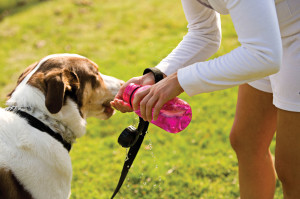 With the dog days of summer upon us, we as pet owners need to be aware of heatstroke in our pets. This can be a life-threatening condition that occurs because your pet cannot lower its body temperature efficiently, so its body temperature increases to dangerous levels.
With the dog days of summer upon us, we as pet owners need to be aware of heatstroke in our pets. This can be a life-threatening condition that occurs because your pet cannot lower its body temperature efficiently, so its body temperature increases to dangerous levels.
There are many common situations that can set the stage for heatstroke. These include: strenuous exercise in hot, humid weather, being a brachycephalic (short-nosed) breed, suffering from heart or lung disease that interferes with efficient breathing, being confined without shade or shelter and fresh water in hot weather, being confined on concrete or asphalt and the most logical-left in a closed up car in the warm weather.
Heatstroke begins with heavy panting and difficulty breathing. The tongue and mucous membranes appear bright red. The saliva is thick and tenacious and the dog usually vomits. The rectal temperature rises to 104 to 110 degrees Fahrenheit. The dog becomes progressively unsteady and passes bloody diarrhea. As shock sits in, the lips and mucous membranes turn gray. Collapse, seizures, coma and death rapidly ensue.
It is important to take emergency measures to begin cooling your pet immediately. One suggestion would be to move it to an air-conditioned building and begin cooling your pet with spraying your pet with a garden hose or immersing it in cool water for up to two minutes. Also if possible, it is helpful to place the wet pet in front of an electric fan. Ice packs work well when applied to the groin and armpit areas because this is the area where the blood is the closest to the surface in the body. Monitor the rectal temperature and continue the cooling process until it falls to 103 degrees. Seeking veterinary assistance is of utmost importance since this is an emergency. Your veterinarian will take steps to reverse the effects of heat, dehydration, and low blood pressure. An IV catheter will be placed and fluids will be given to help get blood flowing to major organs again.
Treatment is aimed to supporting these organs in the hope that the damage that they have sustained isn’t permanent. Unfortunately, it will often take days to know which organs have been affected. Specific treatments may include antibiotics, blood pressure medications and blood transfusions.
Because heatstroke can be so deadly and strike rapidly, it is best to take steps to prevent it. In hot weather, it is best to exercise your pet during the coolest part of the day (early morning and late evening) and always provide plenty of fresh, cool water and rest. A person can also help their pet by cooling them by allowing them to swim or spray them off with a hose after exercising.
Never leave a pet in a car during warm weather-not even for a few minutes with the windows cracked. Brachycephalic dog owners should be extra vigilant, keeping their dogs inside in air-conditioning on hot days. All geriatric, obese, and respiratory compromised pets should be exercised with caution in hot weather.
So remember if your pet is acting distressed, start cooling it down and seek assistance from your veterinarian immediately.
Do You Have A Pet Preparedness Kit?
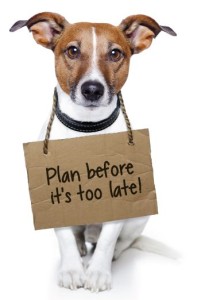 In the last few years, the country has faced many natural disasters like Hurricanes Sandy and Irene, the tornadoes in Missouri and Oklahoma, and the wildfires in the western states. It is important to know that June marks National Pet Preparedness Month as a positive reminder for pet owners to proactively make preparations should they encounter a natural disaster.
In the last few years, the country has faced many natural disasters like Hurricanes Sandy and Irene, the tornadoes in Missouri and Oklahoma, and the wildfires in the western states. It is important to know that June marks National Pet Preparedness Month as a positive reminder for pet owners to proactively make preparations should they encounter a natural disaster.
Many of us consider the pets family so remembering to include your pet in disaster plans can reduce the potential dangers to the pets, their owners, and the first responders. Like humans, pets can become even more stressed or anxious at the onset of a severe weather event, which is why keeping pets calm during the evacuation process is a crucial component. By keeping them calm, this may make the evacuation smoother and reduce the chances of them being left behind or lost during the process.
To insure that your pets are safe during the emergency, it is best to make a plan for their evacuation and also prepare a disaster kit. By doing so, you are protecting the health of not only your pet, but yourself, your family and the first responders.
When making a plan, we must remember that disasters can happen without warning so we must be prepared for these events. This would include:
- Making sure that your pet is wearing a collar and tags with up-to-date information and other identification.
- Making sure that your pet is microchipped and that the microchip is registered in the database.
- Purchasing a carrier for each pet. The pets will be stressed and scared, so this will make transporting a lot easier, and lessen the risk of them getting lost.
- Keep a leash and/or carrier nearby the exit.
- Decide where you and your pet are going to stay.
In the wake of a disaster, the American Humane Associations recommends the following items to be included in a disaster kit. These would include:
- Food (your pet’s regular food)
- Water
- Leash and collar
- Bowls
- Photo of your pet/ID and a photo of you with your pet.
- Your pet’s medications
- Immunization/vet records
- Pet carrier
- First aid kit
- Contact list of pet-friendly hotels, veterinarians, American Red Cross, and out-of town friends or family.
Don’t wait until it is too late. Get started as soon as possible, because we do not know when a natural disaster is going to hit and then it may be too late. If you have any questions, please do not hesitate to contact our office so we can help you protect your furry family member.
Is Your Pet Microchipped?
Millions of pets are lost each year and tragically, few are reunited with their owners. Many lost dogs end up in shelters where they are adopted out to a new home or even euthanized. It is important that your pet have some form of identification on them at all times. Collars and tags are essential, but sometimes they can fall off or become damaged. So wouldn’t it be nice to have some form of permanent identification on them in case they lose their collar and tags?
We are living in a technology based world today, a world where people have needs that they want to be taken care of through technology. Some people have self needs while some have needs for loved ones. In today’s world when people are probably more concerned and caring about the pets than maybe even family members, they want their pets’ needs taken care of as well. This growing need of pet lovers gives rise to a demand of some technological solutions for pets’ safety and security. So because of this microchips and pet GPS technology has arisen.
Microchips are a pet identification system that is made of silicon and other inert “biocompatible “ materials that are nontoxic and hypoallergenic. These rice sized chips are impregnated with a code that is individual to your pet and implanted into the flesh between the pet’s shoulder blades. These chips use radio frequency identification technology that do not actively transmit information. Because of this, they have no batteries so they last for the lifetime of the animal without replacement.
Microchips are very affordable for identifying most of the pets. A common misconception is that they are a GPS-tracking device. This is not true. Although there can be some discomfort in the implantation, it is relatively short in duration, similar to a vaccination. The microchips are virtually impossible to remove or be altered. There are a few minimal shortcomings of the microchips though. Since there are so many different chips on the market, many of them have different frequencies. So some shelters may not have a reader to access the information. Also, sometimes on rare occasions, microchips can migrate from the implantation site making it hard to find and read. Opponents of microchips claim that studies indicate that microchips are a direct cause of cancer. There has been no conclusive evidence to support this claim. Lastly, the microchip is only as good as the registration, so it is important to have the information recorded in a recovery service.
In contrast, GPS devices are actively linked to real-time satellite receivers or cell-phone modems. They are worn outside of your dog’s body and are GPS tracking devises. They are the size of a business card and are attached to a collar. They transmit the exact locale and even directions how to get there once you call or text the device. They can also alert you when your dog strays. The GPS device is relatively more expensive than microchips and some require monthly subscriptions. The GPS unit may be too big and heavy for small dogs to wear. Some areas have little or no cell-phone coverage or internet connectivity and since the GPS is attached to the collar, the device can be lost along with the collar.
So the next time your are thinking about getting technological help for your pets’ safety, think clearly about what is it that you exactly want from the device and then make an informed decision that meets your needs. Both are a lot better than the lost pet poster found on the fences and telephone poles.
For more information, or if I can answer any questions or concerns, please contact my office.
How To Protect Your Pet From Lyme Disease
 With spring here, many people and their pets are starting to enjoy the fresh air. By taking their pet out to the park or wooded areas, they may unknowingly be exposing their pet to Lyme Disease. Lyme disease is caused by a spirochete bacteria called Borrelia burgdorferi and is transmitted to people and their pets through a bite of a deer tick. The bacteria is transmitted while the tick is sucking blood, but the tick must be attached for 48 hours for transmission to occur.
With spring here, many people and their pets are starting to enjoy the fresh air. By taking their pet out to the park or wooded areas, they may unknowingly be exposing their pet to Lyme Disease. Lyme disease is caused by a spirochete bacteria called Borrelia burgdorferi and is transmitted to people and their pets through a bite of a deer tick. The bacteria is transmitted while the tick is sucking blood, but the tick must be attached for 48 hours for transmission to occur.
Lyme disease has been diagnosed in all 50 states in humans, but is more prevalent on the east coast and wooded areas like Minnesota. Lyme disease does not discriminate against the dog breeds, as all breeds are susceptible.
The clinical signs of Lyme disease in dogs are numerous, but it may consist of lameness, fever, swollen lymph nodes and joints and decreased appetite. In severe cases, clinical signs may lead to kidney disease, heart conditions, and nervous system disorders. Animals do not have the typical rash that is seen in humans.
In order to diagnose the disease, blood testing is needed. This testing will tell us if exposure has occurred. If it has, oral medications are indicated. Which usually consists of a 28 to 30 day course of an antibiotic such as Doxycycline or Amoxicillin. Also sometimes other medications may be administered to control the pain and swelling in the pet. Having the disease will not offer any immunity, so the pet can contract the disease again if it is exposed. So it is important to have your dog vaccinated against Lyme Disease if your pet is in wooded areas or tall grasses where the ticks inhabit.
As painful and as dangerous as the disease can be, it is important to try and prevent the disease if possible. This may include periodic testing, use of tick control products such as topical tick control products, or collars, vaccinations, or checking frequently for ticks on your pet. It is also helpful to avoid tall grass or wooded areas.
If you find ticks on your pet, it is best to remove them. They can be removed by grasping them close to the skin with a fine-tipped tweezers. With a steady motion, pull the tick’s body away from the skin. To prevent infection, avoid crushing the tick. After removal, clean the dog’s skin with soap and water and discard the tick by throwing it out in the trash or flushing it down the toilet. Never use petroleum jelly, a hot match, nail polish or other products to remove a tick. It is also best to wear rubber gloves to protect your hands from exposure of the bacteria.
We can also help show you what to do if you have questions. Don’t hesitate to contact our office if you need help!
Top Ten Foods To NOT Give Your Pet
 We often think of our pets as one of the family, which is what they are. But they are not human. Foods that are safe for us may not be safe for our pets and could be toxic to our furry friends. They have allergies just like we do. We need to be aware of what foods to avoid giving to our pets. In general, we are told not to give human food to our cats, dogs, birds, and rodents. This means no table scraps, though most of us are guilty of saving a piece of meat or some potato chips for Tabitha or Fido. We are conditioned to look into those pleading eyes and give in.
We often think of our pets as one of the family, which is what they are. But they are not human. Foods that are safe for us may not be safe for our pets and could be toxic to our furry friends. They have allergies just like we do. We need to be aware of what foods to avoid giving to our pets. In general, we are told not to give human food to our cats, dogs, birds, and rodents. This means no table scraps, though most of us are guilty of saving a piece of meat or some potato chips for Tabitha or Fido. We are conditioned to look into those pleading eyes and give in.
In general, nature eliminates toxic foods before they can do harm by vomiting and diarrhea, before they can be absorbed and cause serious illness. If you suspect your pet has eaten any type of toxic food, please note the amount ingested and contact your veterinarian. Below are my top ten foods not to give your pet.
Chocolate, Coffee, and Caffeine
You probably already know not to feed your dog chocolate, but it is worth mentioning anyway. Chocolate, caffeine, and coffee poisoning in dogs occurs because of a chemical called theobromine, a substance which dogs can overdose on by eating chocolate. If your pet ingests too much of these, they can have severe vomiting and diarrhea, panting excessive thirst and urination, hyperactivity, abnormal heart rhythm, seizures and even death. The dark and baking chocolates contain more theobromine, so are more dangerous than the milk or white chocolates. The average American needs caffeine infused coffee to survive, but this is not true for dogs.
Grapes and Raisins
Grapes and raisins were once thought to be a good treat for dogs—not anymore. Since grapes are such a common people snack, they pose a risk to dogs living in the home. Children munching down on handfuls of raisins may not know that they aren’t doing their pets a favor by sharing. Grapes can cause acute renal failure—a sudden failure of the kidneys—along with vomiting and diarrhea. Scientists still don’t quite know what makes grapes and raisins toxic to dogs.
Macadamia Nuts
Macadamia nuts are the most toxic of all the nuts in dogs and cats. These famous Hawaiian nuts are considered toxic to dogs because they tend to cause gastrointestinal upsets, lethargy, vomiting, and muscle tremors or stiffness. As few as six nuts can cause severe poisoning. Macadamia nuts and walnuts are toxic to dogs, and these can trigger pancreatitis.
Alcohol
It goes without saying to not give your pets alcohol. Some people actually get a kick out of getting their pets drunk. Even small amount of alcohol can be devastating to a pet. To do this intentional is animal abuse. Alcoholic beverages and food products containing alcohol can cause vomiting, diarrhea, decreased coordination, central nervous system depression, difficulty breathing, tremors,, abnormal blood acidity, coma and even death.
Onions and Garlic
Onions, garlic, scallions and shallots contain disulfide, a compound that can damage dogs’ red blood cells. When dogs eat raw onions or garlic, they risk developing hemolytic anemia, which occurs when destroyed red blood cells cannot be replaced. Eating powdered forms of onion or garlic in soups, dips, or sauces is also toxic. Signs or internal damage, such as weakness, orange-colored urine, tiring easily or resisting movement, may not appear for a few days. If you notice these symptoms, immediately take your dog to a veterinarian or emergency clinic where a blood transfusion may be necessary.
Baking Dough
Uncooked break dough that contains yeast can be dangerous for any dog who ingests it. The stomach’s moist warm environment makes it perfect for the yeast in raw dough to rise, which can cause intense discomfort and lead to the dog’s stomach or bowel to rupture. The expanding stomach can press against the dog’s diaphragm, making breathing difficult. If your dog has eaten bread dough, she needs to be examined by a veterinarian immediately.
Avocado
Avocados contain a chemical called Persin which is poisonous to birds and cattle and there have been some reports of dogs getting sick from avocados. It is included on my “thou shalt not” list, because it can lead to diarrhea and vomiting. The giant seed is also a choking hazard, so keep your dog our of the garbage or off the counter. If swallowed, it can block the digestive tract and require emergency surgery.
Xylitol
Xylitol is a sweetening agent used in sugar-free gum and candy, and as a sweetener added to sugar-free baked goods. Products containing xylitol should never be given to or within reach of dogs. Symptoms of xylitol poisoning include vomiting, lethargy, loss of coordination, erratic behavior, disorientation and seizures. Eating candy, gum or baked foods made with xylitol can cause a severe drop in blood-sugar levels, resulting in liver failure. As always, if you suspect that your pet has ingested xylitol, you should contact your veterinarian immediately.
Fatty Foods
Dogs are fond of meat and other high-fat foods, but cooked and uncooked meat table scraps and fat trimmed from meat can cause pancreatitis. Unfortunately, some people treat dogs with leftovers, and dogs sometimes treat themselves by stealing food. Pancreatitis in dogs often follows the consumption of a fatty meal or snack. Your dog may become very sick quickly, and if you notice symptoms such as vomiting, diarrhea and abdominal pain, it should be examined immediately and receive intensive fluid and antibiotic therapy.
Milk
Abdominal cramps and diarrhea are the usual symptoms and maybe severe. Adult dogs and cats are lactose-intolerant. They don’t have sufficient amounts of the enzyme lactase, which breaks down the lactose in milk. It isn’t even recommended to give cow’s milk to puppies and kittens.
This list is only a sampling of foods that can be toxic to your pet. But my best advice is that if you think that it could be bad, don’t feed it to your pet. And of course, contact me if you have any questions.

